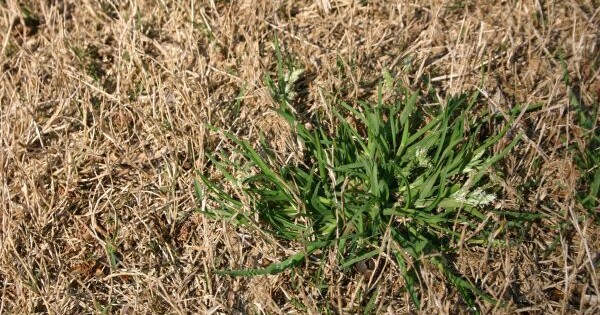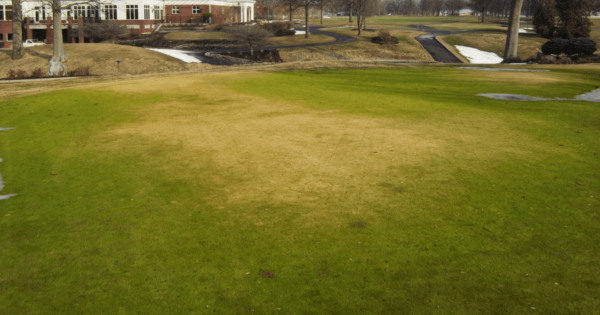Planning for annual bluegrass
Planning for your annual bluegrass management
It seems like annual bluegrass (Poa annua) is one of the most problematic weeds turf managers in the southeast battle every year. This was certainly the case in 2015 as abnormally high temperatures (e.g., areas of green hybrid bermudagrass could be found on golf courses in late December) and rainfall totals in many areas created an excellent growing environment for this troublesome weed that taxed even the most robust herbicide programs.

Green hybrid bermudagrass (C. dactylon x. C. transvaalensis) on a golf course fairway in Alcoa, TN on December 28th 2015. Photo credit: J.D. Murr.
Another factor that complicated annual bluegrass control last year was the continued increase of herbicide resistance at many locations. The University of Tennessee Turfgrass Weed Science program has identified annual bluegrass with resistance to many commonly used pre- and postemergence herbicides across the state and 2015 was no exception. Far too often we see turfgrass managers rely on a single herbicide for annual bluegrass control and apply it for consecutive years without rotation. Simply put, this is a recipe to select for resistant plants at a given site that will eventually erode the number of herbicide options available to control this troublesome weed. More information on herbicide resistance in annual bluegrass can be found here.
Read Also: Time to start planning for Annual Bluegrass
Each year the University of Tennessee evaluates herbicide programs for annual bluegrass control statewide and presents our findings at #PoaDay in April. By researching efficacy at multiple locations, we can better understand the performance of different herbicide programs and provide recommendations for turfgrass managers struggling with Poa control.
With the calendar approaching August, now is the perfect time to evaluate the performance of annual bluegrass control programs and plan for how to manage this weed during the winter of 2016–2017. If a program failed last season, attempt to determine why this might have occurred. Was the correct application rate used? Was the program applied at the correct timing? Were weather conditions around the application favorable for performance? Researching answers to these questions now will aid in developing the best plan of attack against annual bluegrass this coming winter.
Plans are worthless but planning is everything — Gen. Dwight E. Eisenhower
Planning is important even for those whose programs resulted in optimal annual bluegrass control last year. We know that using the same approach every year will simply select for resistant Poa plants over time. Has the same program been implemented for multiple years at your facility? This could be the opportunity to plan a new approach.
Top performing herbicide programs from last season are outlined below. It is important to keep in mind that efficacy of these programs is predicated on plants being susceptible to the herbicide(s) being applied. Those unsure about the susceptibility of Poa at their location can have plants tested at the new UT Weed Diagnostics Center.
Preemergence Programs
These applications must be made prior to annual bluegrass emergence in the fall. Timing of this will vary based on climatic conditions. In much of Tennessee, we typically recommend that preemergence (PRE) programs for Poa be initiated between August 15th-September 1st. Scouting turf for emerged plants prior to application is recommended to ensure optimal performance. Additionally, these herbicides must be watered into soil in order to be effective.
Last season, Barricade 65WG applications at 18.5 oz/A effectively controlled annual bluegrass through January 2016; however, breakthrough was apparent by April, likely due to the abnormally high rainfall totals experienced across much of Tennessee. For example, Memphis received over 16 inches of rainfall in March 2016, exceeding the 30-year average by over 11 inches.
Early Postemergence Programs
These applications are typically made during mid-October after annual bluegrass emergence. Early postemergence programs are able to control both seedling plants that have emerged from soil as well as those that have not yet germinated. Many turf managers prefer this timing to treating in spring when wet soils and cooler temperatures can affect efficacy. Rotating to an early postemergence program is a great option for those that may have relied only on traditional PRE herbicides (e.g., Barricade) to control Poa for multiple years. (Several early postemergence programs performed well last season and would be recommended for 2016–2017 including:
Kerb 3.3SC at 3.6 pt/A
Princep 4FL at 2 qt/A
Monument at 0.53 oz/A
Katana (3 oz/A) + Kerb 3.3SC (3.6 pt/A)
Monument (0.53 oz/A) + Princep 4FL (2 qt/A)

Annual bluegrass control on January 15th, 2016 following an application of Kerb 3.3SC at 3.6 pt/A on October 21st, 2015 in Knoxville, TN. Annual bluegrass plants pictured were resistant to glyphosate.
Postemergence Programs
In Tennessee, these postemergence programs are initiated anytime between February and April. Those choosing to use non-selective herbicides such as Roundup or Finale are on the earlier side of that window given that they need to apply treatments when warm-season grasses are completely dormant to avoid delays in spring green-up. Those using ALS-inhibiting herbicides such as Revolver, Monument, or Katana tend to apply towards the end of that window considering the need for warm temperatures to be effective against annual bluegrass. Several postemergence programs performed well last season including:
Roundup Pro at 32 fl oz/A
Finale at 6 qt/A
Revolver at 17.4 fl oz/A
Monument at 0.53 oz/A
Katana at 3 oz/A
Tribute Total at 3.2 oz/A
Xonerate at 14.5 oz/A
Diversification is the key component to successful, long-term management of annual bluegrass. Successful programs employed in previous years should be rotated in order to prevent resistance from becoming problematic. In situations where previous programs may have failed, selecting a different program may result in improved performance.

Glyphosate- resistant annual bluegrass control on March 9th, 2016 in Knoxville, TN. Plot to the left received Roundup Pro (32 fl oz/A) on January 27th, 2016, while the plot on the right received Finale (6 qt/A) on the same date. Rotating to a herbicide with a different mode action resulted in effective control of this resistant phenotype.


